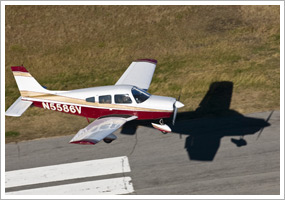| The following stories from the July 8, 2011, edition of AOPA ePilot were provided to AOPA members who expressed an interest in the particular subject areas. Any AOPA member can receive information tailored to their areas of interest by updating their preferences online |
training tipsCross-controlled “The pilot coordinates rudder pressure with aileron inputs to eliminate the effects of aileron drag (adverse yaw) during turns. And coordination during slow flight ensures that an inadvertent stall will not become a spin,” explained the Oct. 11, 2002, “Training Tip: Coordinated flight.” The lessons are clearly learned when the pilot can feel the slipping or skidding of uncoordinated flight—no longer dependent on instrument indications to sense its presence—and makes instinctive corrections. For every rule there is an exception, and there are situations where intentionally uncoordinated flight—that is, flight with crossed controls—is needed. After all the necessary emphasis on coordination, learning to break the rule when appropriate can be a challenge. That learning hurdle is best overcome with lots of practice, resulting in lots of confidence. Slipping maneuvers are a case in point. Putting the trainer into an aggressive forward slip to lose altitude on a power-off or practice emergency landing is short on smoothness and coordination, but long on results. “When performing the forward slip to lose altitude on final approach, the pilot lowers a wing with aileron and feeds in opposite rudder to prevent the aircraft from turning away from the approach course. The airplane's longitudinal axis is now positioned at an angle to its flight path, which increases drag and creates a higher descent rate on the approach,” explained the Feb. 24, 2006, “Training Tip: Forward slips, sideslips.” “‘Sideslipping’ to handle a crosswind on final approach also requires holding a wing low and opposite rudder—but there is an important difference. The aircraft's longitudinal axis is kept aligned with the extended runway centerline.” There are other situations, as when touching down in rough, gusty air, when you must do what’s necessary with the flight controls to maintain runway alignment (rudder) and avoid drift (aileron), even if the momentary result is flying cross-controlled. Most of the time, smooth, coordinated control inputs exemplify correct technique and showcase your knowledge. Demonstrating how to break the rule correctly is another step along the road to your pilot certificate. training productsVFRMap.com adds airport/facility directory searchThe creators of VFRMap.com, a free online source of VFR and IFR charts, have added an airport/facility directory search function. Still in beta, the feature is optimized for mobile browsers. While it will eventually be a part of VFRMap.com, you can check it out here.
Note: Products listed have not been evaluated by ePilot editors unless otherwise noted. AOPA assumes no responsibility for products or services listed or for claims or actions by manufacturers or vendors. final exam
Question: I rent an airplane from my local FBO for my private pilot flight training. Is it necessary for me to have renters insurance?
Answer: While your FBO may not require it, having your own insurance coverage is strongly recommended. Here’s why: An FBO’s insurance policy is designed to protect the FBO, not the renter. You can be held liable for injuries to passengers, damage to property, and even damage to the aircraft itself. Also, if you damage the aircraft and the FBO turns in a claim for damage beyond its deductible to its insurance company, the insurance company can pay the FBO for the damage, and then take action against you to collect the amount it paid to the FBO. This is called “subrogation.” You also could be liable for the FBO’s deductible, which could potentially cost you thousands of dollars. With renters insurance available for less than the cost of a few hours of flight time, it only makes sense to get covered. The AOPA Insurance Agency provides renters insurance. For more information, read “When you rent an airplane, what coverage do you need?”
Got a question for our technical services staff? E-mail [email protected] or call the Pilot Information Center, 800/872-2672. Don’t forget the online archive of “Final Exam” questions and answers, searchable by keyword or topic. |
 Student pilots hear a lot about coordinated flight at the outset of training. It can’t be emphasized too much to the beginning student pilot that the flight controls, when applied in harmony, produce smooth maneuvers that guarantee safety and meet
Student pilots hear a lot about coordinated flight at the outset of training. It can’t be emphasized too much to the beginning student pilot that the flight controls, when applied in harmony, produce smooth maneuvers that guarantee safety and meet 